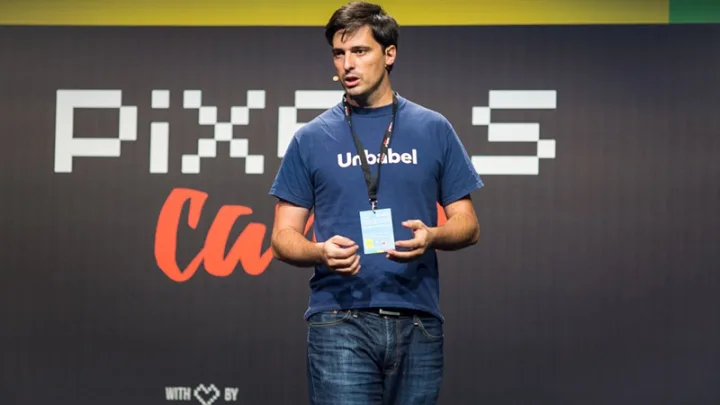Knowing English is great, isn’t it? You can watch blockbuster hits in the original version, understand the lyrics of your favorite songs, and travel the world with minimal hassle.
There’s just one problem: 80% of the world doesn’t speak English. Think about that. Have you ever thought about the potential of those untapped markets?
Think no more. Just tap a button and that video you filmed is instantly translated and transcribed into hundreds of languages at native-speaker quality.
How? With Unbabel: a sophisticated augmented intelligence service, where machines and humans work together to boost your company’s reach.
I spoke with cofounder and CEO Vasco Pedro on the future of human-machine interfaces, and the latest conversation unfolding between human language and machine learning algorithms.
“The merging of human and AI is going to happen first, before you get to fully autonomous AI.”
AI-powered, human-refined translation as a service
EJ: Unbabel is an “AI-powered, human-refined translation as a service.” What does this mean?
VASCO: Our goal is to enable companies to communicate with their customers in any language, through a combination of artificial intelligence and a crowd of humans.
Translation is becoming more and more essential to any company that wants to be global and operate in multiple markets. We have a “translation as a service” mentality— where high-quality translation is always available, seamless, and integrated with the applications you use.
“Machine solutions—or AI—don’t yet provide a quality translation experience. And human solutions—or translators—are expensive and hard to scale.”
So we provide the best of both worlds: machines do the initial work, and then our community of humans refines the AI translations to native-speaker quality.
EJ: So is this more machines helping humans to translate a language? Or are the humans helping the machines with post-editing after the initial work?
VASCO: That’s a great question ultimately it depends on the use case—so translating an email is very different than translating some high-end marketing text, which is very different than translating a chat or subtitles.
With marketing content, for example, machines still need a lot of human help. So here it’s really more the machines helping to alleviate the amount of human effort.
But this is slowly shifting with certain types of content. If you look at chat, we’re already doing 80% machine translation, 20% human. So it’s starting to feel a little bit more like humans are helping the machine to achieve the desired result.
EJ: What made you realize there was a need for this service?
VASCO: The trigger was really a conversation I had with a friend who was renting out an AirBnB. People were reaching out to him in multiple languages he didn’t speak. So he would use Google Translate, but it would say ridiculous things and he didn’t trust it. That was the kickstart that got us thinking, “Yeah, there should be a better solution.”
And then slowly we saw the huge gap in the ability to process language in an enterprise setting, and the potential reach that this idea could have in the world.
Putting the human in natural language processing
EJ: How important is understanding human language for creating a program that can translate from one language to another?
VASCO: I think that’s the holy grail—and the reason we haven’t really cracked this problem. Because you need to capture the semantic structure of language, and that’s really hard.
Meaning and semantics are very closely tied to intelligence. We don’t really understand how our brains work enough to even understand how we humans do it. Once we understand the semantics of language, then translating will be the easy part.
“Humans have an incredible incentive to evolve and improve—and machines don’t really have purpose.”
EJ: And does it work the other way around? By trying to teach machines how to learn a language, are we learning anything about how humans learn? Or are natural language processing (NLP) and human language two separate things that minimally inform each other?
VASCO: They inform a little bit. So for example, Chomsky’s Universal Grammar revolutionized the linguistics field. And then computational linguistics came in and disproved some of the stuff that Chomsky was saying and changed our perception of language.
So NLP is not a direct representation of the model of human language, because we don’t understand language well enough. But it does provide us fertile ground to test certain theories of how language works.
EJ: Your Unbabel team page says that you’re a father of four girls. True?
VASCO: Yes.
EJ: Within three years, these kids go from having absolutely no language to being fully proficient language users. And this is amazing. Does this inspire you to build better algorithms? Or do you see this gap between people and machines and think, “Holy shit, we’re not even close here?”
VASCO: Yeah, we’re not even close here. We don’t understand how our brains learn this fast.
“People are exposed to way less language than the current machine translation is—like a couple orders of magnitude less—and still kids learn much faster.”
There are a couple reasons for this. On one hand, there’s a grounding of your experience through physical sensations. So when you talk about a table, you have some sort of connection to a physical table and how you interact with it. And this helps you define that concept, but machines don’t really have that yet.
But the other is that we just don’t understand how intelligence works. We don’t understand what creates consciousness. And humans have drives, right? We have the drive to achieve certain things; the drive not to die, to eat and avoid pain. This creates an incredible incentive to evolve and improve—and machines don’t really have purpose.
Brain-machine interfaces and the future of artificial intelligence
EJ: You have a community of around 50,000 translators that help Unbabel refine machine translations. So what’s more likely to happen first: the demand for Unbabel grows faster than you can scale the human side of your service? Or the algorithms get good enough that you no longer need this human side?
VASCO: It’s a very interesting question. So far, we haven’t had a big issue scaling our community. And the technology will continue to evolve, which means that the amount of effort on a per-word basis will be reduced—you can do more with the same number of people.
“Worst case scenario, you’ll always need humans to generate the data to train the engine.”
But at the same time, I don’t see a point in the next five years where you don’t need humans. Worst case scenario, you’ll always need humans to generate the data to train the engine.
So I think that depending on the type of content, you’ll see machines taking over at different speeds.
EJ: Let’s jump even further ahead: you’ve just raised $23 million to build out this AI-powered, human-refined translation service. Elon Musk has just raised the same amount of money for one of his new ventures, Neuralink, to build brain-machine interfaces to connect humans and computers. What do you think about this? Is this realistic? How far off is this?
VASCO: I think it’s fascinating. I’m a big believer in the brain-to-computer interface. Augmenting the bandwidth between your brain and your computer is key for the future of AI.
“Before we achieve fully autonomous AI, we’ll actually have humans embedding AI components in their brains.”
The merging of human and AI is going to happen first, before you get to fully autonomous AI.
But it’s so very, very early. We can only map about 200 neurons of the brain in real time. There’s a DARPA challenge to get to a million by 2020. But we humans have 70 billion of them, right? So even if you increase at Moore’s Law speed, both of us will be dead before you can map a rat’s brain. It’s quite a daunting task.
Even here at Unbabel, we’re starting to look at brain-to-computer interfaces as a way of speeding up communication.
So I think it’s fascinating. I think Neuralink’s 23 million is very small. But I imagine it’s to make just enough progress to demonstrate that they have a path.
“If you crack the brain-to-computer interface, it’s a game changer for humanity.”
EJ: I suppose whether or not we’re both dead before all this happens depends on whether Ray Kurzweil has his way.
VASCO: Yeah, for sure. [laughs]
A world without language barriers
EJ: We’ve been talking about machines and artificial intelligence, but there’s also a very human vision that you have through unbabel.org—where you’re “accelerating a shift toward a world without language barriers.” Can you explain this challenge?
“The translation layer shouldn’t just be for enterprise. It should be for everyone in the world.”
VASCO: Well, one of the biggest problems in times of crisis is language. Take the issue of refugees. A lot of refugees hit a different country, and they don’t speak English, they don’t speak any other language. So they can’t really integrate and adapt. It just makes everything harder.
“Language barriers become even more of a challenge when you’re in the middle of a crisis.”
So from the beginning, we wanted Unbabel to be able to help people in need through NGOs. And now we have people who routinely volunteer for those NGOs, providing translation for free.
I think it’s a first step to the vision of Unbabel. The translation layer shouldn’t just be for enterprise. It should be for everyone in the world.
Surfing to pay off emotional debt
EJ: Let’s end on some waves. You’ve said that you use surfing to improve communication with your teams—to make hard conversations easier. And you tie this to something you call “emotional debt.” How does this work?
VASCO: So it doesn’t have to be surfing, per se. But the idea is that having a startup is to the founders what having a baby is to a couple:
In the beginning, it’s all-consuming—it requires your attention, a lot of time, maybe you don’t sleep well. And you have more stress and less time to communicate as a couple, especially to discuss the little things.
This creates an accumulation of emotional debt. In a startup it’s fine to have technical debt. Most startups do, along with other types of debt, like sales debt or marketing debt. But emotional debt is something that founders have to avoid.
“The number one killer of startups is an emotional debt.”
The emotional debt is the small things you don’t discuss during the week. Then suddenly there’s a big decision coming but you’re not really communicating anymore—you’re talking from a place built on preconceptions, instead of from a place of compassion and transparency and curiosity.
And surfing helps, because we’d spend an hour exercising in the ocean where we’re forced to focus. Then afterwards, we’d have lunch on the beach with some great conversations. And it reminds you, “Oh, yeah, I’m not only doing this with people I respect, but with people I really enjoy hanging out with—with friends.”
So those are the moments where you have the best conversations about really hard topics. Because you’re coming from a place of compassion and transparency, and you allow yourself to be vulnerable—which means that the other person can also be vulnerable. And this is where we have real conversations.






